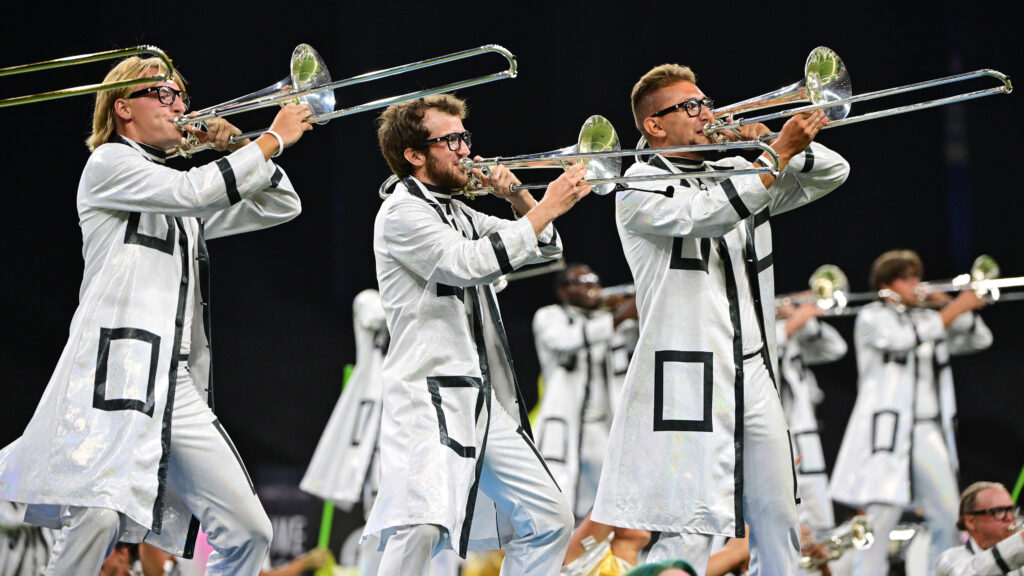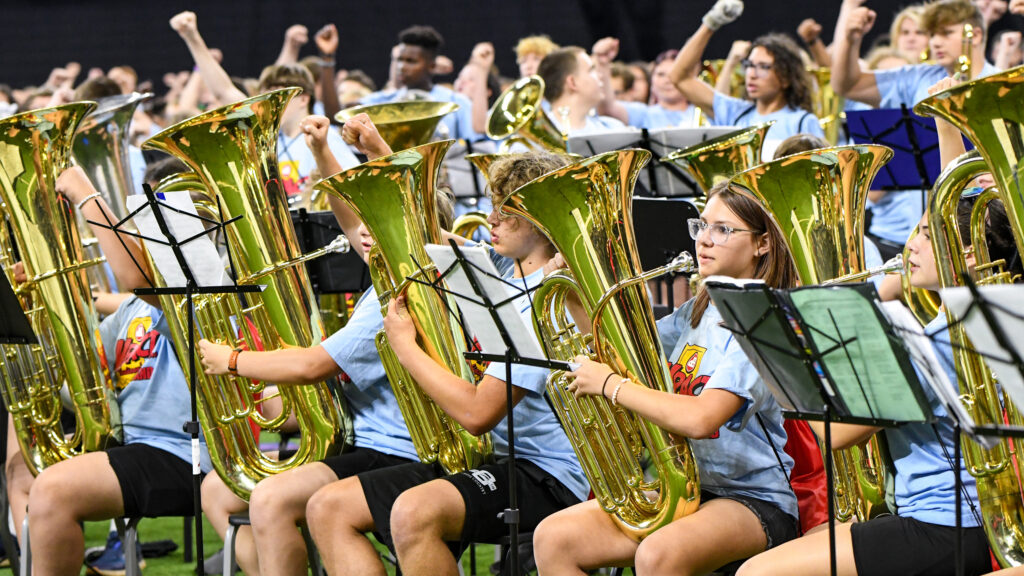The process of selecting a “winner” from among the world’s most elite and exclusive marching music ensembles is not an easy task. Just ask any of the highly qualified professional men and women who comprise the DCI judging team in a given season.
What might seem obvious on the surface may be masked by the complexity of Drum Corps International’s judging system which takes into account an entire process combining the creativity of a corps’ program and the outstanding performers who bring the show to life.
Drum Corps International’s member corps create the judging system. On a biennial basis, instructors and designers of the activity meet to present their views about how the system should be interpreted, refined and revised. Such was the case this past winter when DCI member corps representatives voted to retool the percussion caption, adding a second percussion judge at select events.
With the DCI Southwestern Champonship this past weekend in San Antonio being one of the first events of the 2016 season to utilize an extended panel of judges as will be seen at the DCI World Championships this August, DCI Artistic Director Michael Cesario sat down with DCI.org to give a general overview of how the judging process works and the responsibilities of each judge.
Captions and Criteria
A standard DCI adjudication panel consists of eight judges but varies based on time of season and event.
General Effect

Caption: General Effect (GE)
Number of judges: Two for most of the season, plus a doubled panel of four during Premier Events (e.g. San Antonio, Atlanta, Allentown) and the World Championships.
Points allotted: 40, 20 from each of the two judges. The scores of the two Effect captions are counted for full value. When the panel is doubled, the score of all four judges is divided in half.
Responsibilities: One of the GE judges has a music background and the other has a visual background, but each utilizes the same judging sheet because they are effectively judging the entire show, not just the effect of the music offering or the effect of the visual production. GE judges must be the most experienced, most knowledgeable, and most flexible members of the audience. Plus, they know how to manage numbers in order to give a proper score. The GE judges are doing the romantic job, they’re feeling what the show is offering and responding to what the show is. There are three parts to GE, the intellectual, the aesthetic, and the emotional.
Music Analysis, Visual Analysis

Caption: Music Analysis, Visual Analysis
Number of judges: Two (One for Music and one for Visual)
Points allotted: 20 each, but divided in half before being added to the final score.
Responsibilities: The Music Analysis and Visual Analysis judges are the classically trained judges, the most scientific in their approach. They analyze how the pieces of the puzzle fit together and they focus on the detailing … how is the music or visual orchestration done, how well is that utilized, what are the developmental phrases, and how is the show composed and constructed.
Visual Proficiency

Caption: Visual Proficiency
Number of judges: One
Points allotted: 20, but divided in half before being added to the final score.
Responsibilities: The Visual Proficiency judge zooms in and out on performers, but from the periphery of the field. They look at small groups and individuals, but try to not focus on any particular person. This is the judge that used to be referred to as Field Visual, and earlier, Marching and Maneuvering.
Color Guard

Caption: Color Guard
Number of judges: One
Points allotted: 20, but divided in half before being added to the final score.
Responsibilities: The Color Guard judge, placed in the stands or press box, is strictly judging the proficiency of each guard, what the guards are achieving and how they are achieving it. To put it another way, what the guards are doing and how well they are doing it. This caption is NOT about the effectiveness of the guard, nor is it about the costumes nor the flags.
Brass

Caption: Brass
Number of judges: One
Points allotted: 20, but divided in half before being added to the final score.
Responsibilities: The Brass judge is the easiest to explain as they do what they’ve always done; judge the quality of the brass line.
Ensemble Percussion

Caption: Ensemble Percussion
Number of judges: One
Points allotted: 20, but divided in half before being added to the final score.
Responsibilities: The Ensemble Percussion judge needs a little explaining because that’s a brand new caption with brand new criteria to adjudicate, replacing the Percussion 1 and Percussion 2 judges of previous years. This judge explores every percussion voice, from the front ensemble and the battery (marching drum line), and determines how well those various voices come together. The entire percussion ensemble is judged from various venues, possibly from the press box and possibly from within a position in with the audience, wherever the judge can best hear and see the entire percussion ensemble.
Field Percussion

Caption: Field Percussion
Number of judges: One (utilized at select shows only)
Points allotted: 20, but divided in half before being added to the final score.
Responsibilities: For select Premier Events and the World Championships, a downstairs percussion judge is added who adjudicates from the field, sampling individuals and small groups.
Adding Things Up to 100 Points

There are three caption totals that are listed on the recaps, General Effect, Visual, and Music that combined add up to 100 points. General Effect is worth a total of 40 points. The Visual caption total accounts for 30 points, and is comprised of the sub-captions of Visual Analysis, Visual Proficiency, and Color Guard. Each of those sub-captions receives 20 points before being divided in half for the total Visual caption total. The Music caption total also accounts for 30 points, and is comprised of the sub-captions of Music Analysis, Music Brass, and Music Percussion. Each of those sub-captions receives 20 points before being divided in half for the total Music caption total.
To understand how the scores are added up, it’s important to know that different numbers of judges are used during the season. Five judges were utilized on certain nights from the beginning through the middle of the season. Every five-judge panel included two GE judges, plus another two judges, one each for Music Analysis and Visual Analysis. The fifth judge was a Proficiency (performance) judge who might have been judging Brass, Percussion, Color Guard, or Visual. Therefore, on some nights, the Music score only reflected the Music Analysis caption, which was not divided in half for those contests. On other nights; the Visual score was based solely on the Visual Analysis score, which also was not divided in half for those contests.
At the shows when eight-judge panels have been used, three more judges were inserted into the mix, each of those a Proficiency judge added to the single Proficiency judge described in the five-judge panel above. Every eight-judge panel includes a judge for Brass, Percussion Ensemble, Color Guard, and Visual Proficiency. This configuration is the one reflected two paragraphs above.
A nine-caption/11-judge panel is utilized at select events from the DCI Southwestern Championship (San Antonio) through the end of the season. For those contests, the Field Percussion judge is added and the General Effect panel is doubled from two to four judges. For these shows, the Field Percussion score is added to the Ensemble Percussion score, with the total Percussion sub-caption score then divided in half. That is how we end up with some scores taken to the third decimal that end with a three or an eight. (Those scores start out as .0025 or .0075, but to avoid taking the decimals out to four placements, the scores are rounded up to three decimals.)





